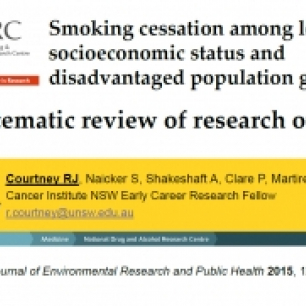This is a copy of the five-minute poster presentation made by Dr Ryan Courtney at the 2015 NDARC Annual Research Symposium.
Abstract
Background: Smoking cessation research output should move beyond descriptive research of the health problem to testing interventions that can provide causal data and effective evidence-based solutions. This review examined the number and type of published smoking cessation studies conducted in low-socioeconomic status (low-SES) and disadvantaged population groups.
Methods: A systematic database search was conducted for two time periods: 2000-2004 (TP1) and 2008-2012 (TP2). Publications that examined smoking cessation in a low-SES or disadvantaged population were coded by: population of interest; study type (reviews, non-data based publications, data-based publications [descriptive, measurement and intervention research]); and country. Intervention studies were coded in accordance with the Cochrane Effective Practice and Organisation of Care data collection checklist and use of biochemical verification of self-reported abstinence was assessed.
Results: 278 citations were included. Research output (i.e. all study types) had increased from TP1 (27% - 75/278) to TP2 (73% - 203/278) (χ² = 73.13, p < .001), however, the proportion of data-based research had not significantly increased from TP1 and TP2: descriptive (TP1 = 23% vs. TP2 = 33%) or intervention (TP1 = 77% vs. TP2 = 67%). The proportion of intervention studies adopting biochemical verification of self-reported abstinence had significantly decreased from TP1 to TP2 with an increased reliance on self-reported abstinence (TP1 = 12% vs. TP2 = 36%).
Implications of the research: The current research output is not ideal. The current pattern of research output with little intervention research output is not optimal to decrease smoking rates. Research institutions, scholars and funding organisations should take heed to review findings when developing future research and policy.


